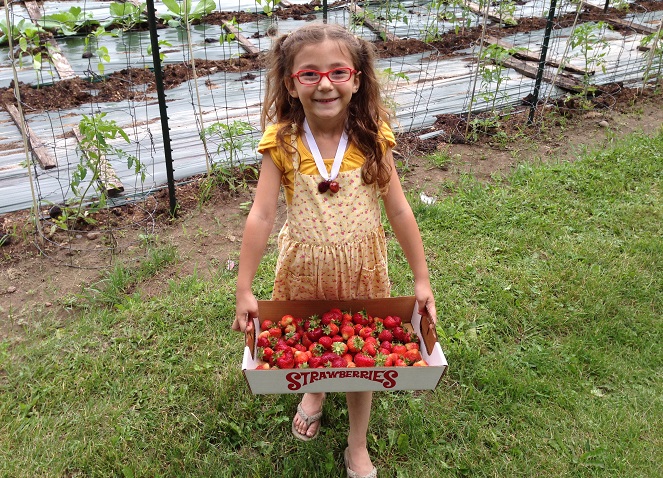 Whether you have your own garden, belong to a CSA (Community Supported Agriculture) or want to buy up all those nicely priced seasonal veggies, preserving your harvest has many benefits.
One of the key advantages of home preserving is that you are limiting your exposure to the chemicals and pesticides used on many commercially available food products. You are in charge of what is going in to your food.
A specific chemical of concern is BPA (Bisphenol A), a chemical that has been shown to disrupt hormones. Preserving your own foods in non-plastic containers will make sure you are keeping your food BPA-free. The positive environmental impact of preserving your food versus buying pre-packed foods is also a big advantage. For example, it reduces the waste associated with pre-packed foods; you can reuse the glass jars you use to preserve again and again. You are also reducing the amount of energy that is being used to move that commercially produced food from farm to factory to store to table.
You can preserve your harvest in a number of ways, including canning, freezing, fermenting, drying and pickling. The Zero-Waste Chef, Anne-Marie Bonneau, believes that fermenting is the way to go. In a recent post, Bonneau explained, “The good bacteria present in fermented foods offer all sorts of benefits. Fermented vegetables contain higher levels of vitamin C plus B vitamins, such as thiamin, riboflavin and niacin. Phytates in grains, nuts, seeds and legumes bind to minerals, making nutrients unavailable for absorption. Fermentation breaks these bonds so the body can absorb the previously unavailable nutrients.”
Freezing your harvest is also a good way to preserve the nutrients in your produce and that just-picked flavor. The only downside is you have to have enough freezer space, and that freezer is using energy.
Some resources to help you get started:
Whether you have your own garden, belong to a CSA (Community Supported Agriculture) or want to buy up all those nicely priced seasonal veggies, preserving your harvest has many benefits.
One of the key advantages of home preserving is that you are limiting your exposure to the chemicals and pesticides used on many commercially available food products. You are in charge of what is going in to your food.
A specific chemical of concern is BPA (Bisphenol A), a chemical that has been shown to disrupt hormones. Preserving your own foods in non-plastic containers will make sure you are keeping your food BPA-free. The positive environmental impact of preserving your food versus buying pre-packed foods is also a big advantage. For example, it reduces the waste associated with pre-packed foods; you can reuse the glass jars you use to preserve again and again. You are also reducing the amount of energy that is being used to move that commercially produced food from farm to factory to store to table.
You can preserve your harvest in a number of ways, including canning, freezing, fermenting, drying and pickling. The Zero-Waste Chef, Anne-Marie Bonneau, believes that fermenting is the way to go. In a recent post, Bonneau explained, “The good bacteria present in fermented foods offer all sorts of benefits. Fermented vegetables contain higher levels of vitamin C plus B vitamins, such as thiamin, riboflavin and niacin. Phytates in grains, nuts, seeds and legumes bind to minerals, making nutrients unavailable for absorption. Fermentation breaks these bonds so the body can absorb the previously unavailable nutrients.”
Freezing your harvest is also a good way to preserve the nutrients in your produce and that just-picked flavor. The only downside is you have to have enough freezer space, and that freezer is using energy.
Some resources to help you get started: - Ball, the company with the canning jars and accessories, has a great site to help with all things related to preserving. There are step-by-step guides, reference tools and much more.
- There is also an online how-to put out by the U.S. Department of Agriculture, Complete Guide to Home Canning.
- The Big Book of Preserving the Harvest: 150 Recipes for Freezing, Canning, Drying, and Pickling Fruits and Vegetables by Carol W. Costenbader has step-by-step instructions for stocking the pantry and preserving the harvest through freezing, canning, drying, cold storage, pickling and making jams, jellies and vinegars from fruits and vegetables.
- Home Canning Guide at Mother Earth News – This site is full of information, recipes and resources for preserving your harvest.
- Saving the Season is an entertaining, well-written blog about “home canning …and it will cover jams and other fruit preserves, pickles and briny things, canned vegetables (above all tomatoes) and the complement of condiments that includes relishes, sauces, salsas and those related preparations that result when you chunk bits of seasonal produce and preserve them in a syrup either piquant or sweet.”
“Preserving is an extension of the values that made you shop in the farmers’ market in the first place.” – Eugenia Bone